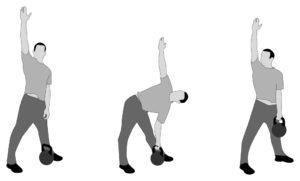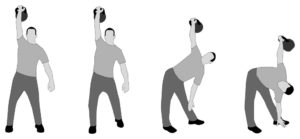Welcome to the third instalment of our kettlebell workout guide. This week you’re in for a treat. Today we’re talking about the kettlebell windmill excercise. It’s renowned as a total body workout that focuses on the abs and obliques. What’s more there are three separate kettlebell windmill routines all covered in this guide.
But first, what is a kettlebell windmill? I’m glad you asked. The windmill gets its name because of the arm movements involved in this routine. Be prepared to seriously strengthen your core, work those shoulders and improve your mobility. You’ll also stretch those hamstrings and tone your derrière. With three variations to choose from: Low Windmill, High Windmill and Double Windmill there is no excuses to not include the kettlebell windmill in your routine.
Kettlebell Windmill Muscles Worked
Contents [show]
This is a total body routine that focus on the core. Expect to work the following muscles:
- Abs
- Obliques
- Shoulders: particularly the external rotaters
- Neck
- Triceps
- Hips
- Back (Upper & Lower)
- Hamstrings
- Glutes
Kettlebell Windmill Benefits
As well as working multiple muscle groups, the kettlebell windmill benefits you by improving flexibility, stability and mobility. It will also teach you body awareness and control. As mentioned there are also three different variations so it’s a routine suitable for beginners and advanced users.
If you have ever suffered from back or shoulder pain, the combination of muscles worked can be a great way of preventing further injury. The strengthening of muscles around problem areas can also help to your improve posture.
The windmill also works your lateral chain which is one area of the body notoriously difficult to target with traditional workout routines.
Before you start
It’s always important to warm-up before exercising, I strongly recommend against going into the kettlebell windmill cold. With so much focus on arm, shoulder and back movements it’s important to get the blood pumping prior to working out. If you’re unsure where to start, I recommend the following kettlebell warm-ups:
- Shoulder roll
- Arm and shoulder stretch
- Sleeping warrior (lats and lower back)
- Upward dog (chest, hip flexors and lower back)
- Jumping jacks
- Arm scissors
- Side to side stepping lunge
Regardless of which kettlebell windmill routine you choose; ensure your movements are slow and controlled. If unsure, I always recommend attempting a dry run first (without a kettlebell), just to get your body moving correctly.
Kettlebell Low Windmill
This is where to start if you’re new to kettlebell training, or have never attempted a kettlebell windmill. This routine is easy to master and focuses heavily on the abs.
Starting Position
Start with your feet shoulder width apart. Place the bell so that it is level with the inside of your left foot. Drive your left hip out so that your left leg and foot is at a 45 degree angle. As you do this, lock your right leg in a straight position with your right foot still facing forwards. Next, lift and lock your right arm so that it is lifted over you right shoulder.
Kettlebell Low Windmill Technique
Step 1: Your going to be picking up the bell with your left hand. Make sure your neck and back remains straight and the movement comes from the hips. Start by kicking your hip out to the right. This will prevent upper body rotation as you reach down for the kettlebell with your left hand. As you move downwards, keep your right arm locked and your eyes fixed on the hands. This will help ensure your neck remains straight. Finally, as you move to pickup the bell make sure your shoulders remain stacked throughout. If you drop your shoulder the maneuver becomes less effective.
You’ll want to end step one in an upright position, head facing forwards with the bell in you left hand. Your right arm should still be locked and above your right shoulder.
Step 2: This is the reversal of step one. Kick your hip out to the right. Make sure your left leg and foot is at the 45 degree angle before slowly returning the bell to its starting position. Move slowly and ensure your shoulders remain stacked.

Kettlebell High Windmill
Sometimes called an overhead windmill, this is an advanced kettlebell routine that can be dangerous if not done correctly. The key is to keep the spine straight and your shoulders and hips parallel. The basic movements are the same as the low kettlebell windmill. Expect to work muscles harder, particularly the shoulders, hamstrings and glutes as you get closer to the ground.
Starting Position
With the kettlebell in your right hand, lift your arm straight above your right shoulder. Keep your head facing forward and open your legs so that they are shoulder width apart. Once again, push your left hip outwards so your left leg and foot is at a 45 degree angle.
Warning: Do not overload the weight during this maneuver. Start small and work up your resistance.
Kettlebell High Windmill Technique
Step 1: Turn your head so that you are looking at the bell in your right hand. Kick your hip out to the right and using your left hand as a guide, let it slide down your left leg all the way to the floor (or as far as you can go). As you do this you will feel your left hamstring tightening. As you move down, make sure to keep your eyes on the bell and your both arms, spine and knees straight. Your right shoulder will rotate in a clockwise direction as you reach the floor. This is your external rotators working.
Step 2:Once you are as far down as you can go, your left and right arms should be in a straight line. It’s now time to return to the starting position. To do this, you will use your glutes, abs and left leg. As you move up your right arm will rotate in a anti-clockwise direction.
Note: As you move up and down, the kettlebell should not move from side to side. The correct movement is up and down.

Double Kettlebell Windmill
Once you’ve mastered the high windmill you’ll be ready to take things up a notch with the double windmill routine. This routine is almost identical to the high windmill but instead of having a hand free to guide you down, you’ll be using a second kettlebell. Unsurprisingly this routine works the exact same muscles as the high windmill but much more intensely.
Beginners:
- You should not attempt this routine without having first mastered the low and high windmill.
- Try using a heavier weighted kettlebell in your guide hand and a lighter one in your overhead.
Advanced:
- You should use two equally weighted kettlebells.
Starting Position
Pick the two kettlebells up and open your legs so your feet are shoulder width apart and facing forwards. Once again, turn your left leg and foot so they are at a 45 degree angle. With the kettlebell still in hand, lift your right arm so that it is straight over your shoulder.
Double Kettlebell Windmill Technique
Step 1: Keeping your weight so that it is on your right leg, push your hips out to the right. Slowly guide your left arm down all the way to the floor. As you do this your right arm should begin to rotate clockwise, allowing the bell to move down with your body in a straight line. As you move down, make sure your eyes are looking overhead at the kettlebell in your right arm. This will help keep your spine straight which is essential for this routine. Make sure you keep as much weight as possible on your right leg – this will help you in step 2.
Note: Do not be tempted to cheat by bending your legs, they should remain straight at all times.
Step 2: To return to the starting position, begin by driving with your right leg. You will feel your glutes and abs working as you rise up. Just before returning to the starting position, you should feel your left hamstring working. To ensure the kettlebell remains in the correct position you should feel your right arm rotating anti clockwise.
That’s all for this week folks. If you’re looking for another kettlebell workout, why not check out part one (kettlebell sumo deadlift) or part two (kettlebell renegade row).
Keep a look out for part four, i’ll be introducing the kettlebell slingshot – it’s a great warm-up excercise that works the core and obliques. You can also use it in between more strenuous routines.
